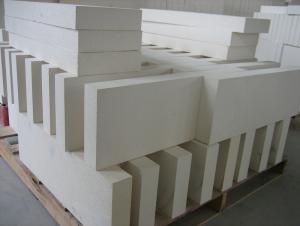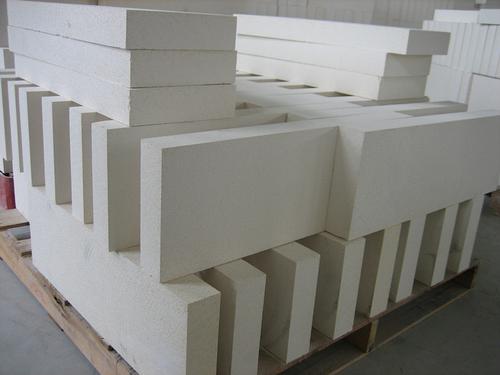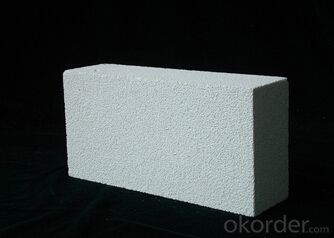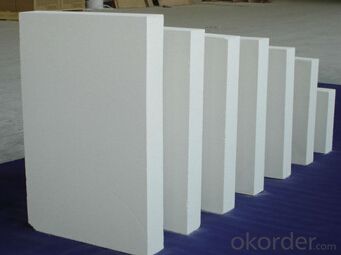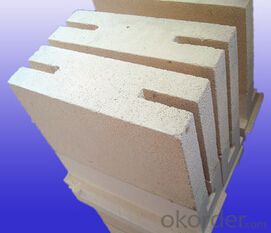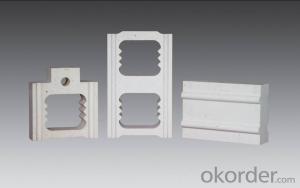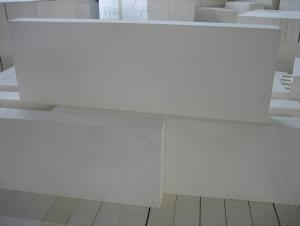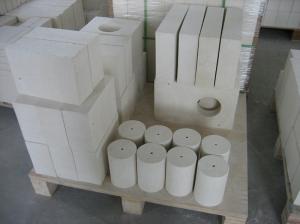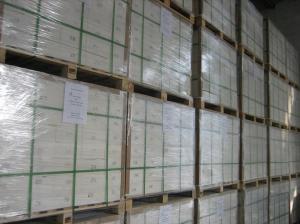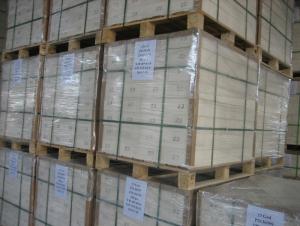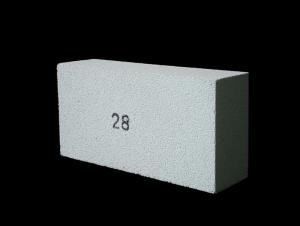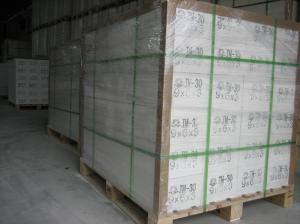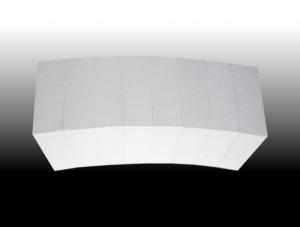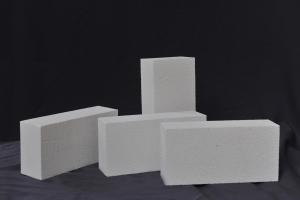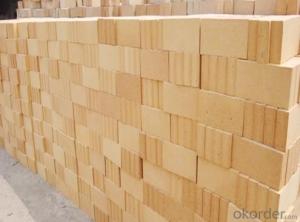Refractory Mullite Insulating Refractory Brick JM 32
- Loading Port:
- Shanghai
- Payment Terms:
- TT OR LC
- Min Order Qty:
- 20 m.t.
- Supply Capability:
- 20 m.t./month
OKorder Service Pledge
OKorder Financial Service
You Might Also Like
General Information
CMAX insulating firebricks are classified under temperature between 1300℃ to 1700℃, manufactured from high purity alumina clay.
1. Lower content of iron, alkaline and impurities, good high temperature properties.
2. Homogeneous structure, light weight, energy saving because lower heat storage in the furnace during cooling cycles.
3. High strength, good thermal shock resistance under high temperature.
4. Precise sizes due to grinding and shaping after sintering, which meets the requirement of construction.
5. Max service temp: Up to 1730C (3160F)
Feature
Light weight and low thermal conductivity
Low heat storage
Low iron and impurities
High thermal shock resistance
Application of Insulating brick
Metallurgical Industry: blast furnace, hot blast furnace, heating furnace, etc..
Petrochemical Industry: ethylene cracking furnace, hydrogen furnace, the main furnace, heating furnace, etc..
Ceramic industry: roller kiln, kiln, etc..
Glass industry: glass furnace regenerator, etc.
Carbon industry: carbon furnace, etc..
Aluminum electrolysis industry: aluminum reduction cell, etc.
Other industries: tunnel kiln, shuttle kiln, etc.
Advantages of heat insulation brick
Low thermal conductivity: many air holes will bring good thermal insulation effect, energy saving.
High crushing strength: high crushing strength, volume stability.
Low heat storage: small heat storage, absorb more heat, energy-saving effect is obvious.
Technical Data
ITEM | GJM30 | GJM28 | GJM26 | GJM23 |
Classification Temperature, ℉/℃ | 3000/1650 | 2800/1540 | 2600/1430 | 2300/1260 |
Bulk Density,g/cm³ | ≤1.0 | ≤0.9 | ≤0.8 | ≥0.5 |
Reheating Linear Change, % | ≤0.9 (1550℃,12 h) | ≤0.8 (1510℃,12 h) | ≤0.7 (1410℃,12 h) | ≤0.5 (1230℃,12 h) |
Al2O3 Content, % | ≥75 | ≥65 | ≥55 | ≥45 |
Fe2O3 Content, % | ≤0.5 | ≤0.6 | ≤0.7 | ≤1.0 |
Thermal Conductivity: | ||||
800℃, w/m.k | ≤0.39 | ≤0.37 | ≤0.35 | ≤0.18 |
1000℃, w/m.k | ≤0.43 | ≤0.41 | ≤0.39 | ≤0.20 |
1200℃, w/m.k | ≤0.48 | ≤0.46 | ≤0.43 | --- |
Insulating brick
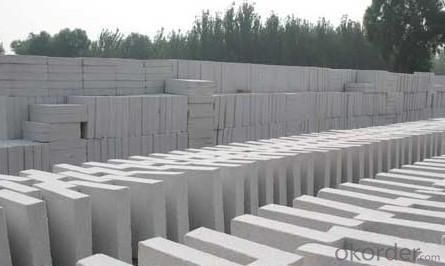

Common problem solution
1. What products do you have?
We have all kinds of refractory bricks, refractory casting materials, mortar, cement, ceramic fiber products, etc..
Or you can browse our products to choose what you need.
2. How to control product quality?
With strict quality control system throughout the material selection and production process, we have the quality of refractory materials and ceramic fiber products to meet customer requirements.
From the selection of raw materials, the quality of our control to start. The quality of the raw materials required for each batch of products in the use of the front line test. In the production process, through the quality control of workers, and then to each piece of classification, and through quality supervision and inspection.
3. Could you give me a brief introduction to the application of your product?
My Company is mainly engaged in steel, cement, glass, ceramics, petrochemical, electric power and other industries.
4. If I need you, what kind of information do you need?
In order to select the right products, we will provide us with information, such as the United States, technical data, order quantity, product applications, etc..
If you have any questions, please contact us.
- Q: Are insulating fire bricks resistant to thermal fatigue?
- Yes, insulating fire bricks are generally resistant to thermal fatigue due to their ability to withstand repeated heating and cooling cycles without significant damage or deterioration. Their high thermal shock resistance and low thermal conductivity make them ideal for applications where thermal cycling occurs frequently.
- Q: Can insulating fire bricks be used in power plants?
- Yes, insulating fire bricks can be used in power plants. These bricks are designed to withstand high temperatures and provide excellent insulation, making them suitable for various applications in power plants, such as lining furnaces, boilers, and kilns. Insulating fire bricks help to conserve energy, improve efficiency, and maintain a stable temperature within power plant equipment.
- Q: Do insulating fire bricks have low thermal conductivity?
- Yes, insulating fire bricks have low thermal conductivity. These bricks are specifically designed to minimize heat loss and provide excellent insulation properties. The low thermal conductivity of insulating fire bricks is due to their composition, which typically includes lightweight materials such as clay, silica, and alumina. These materials have low thermal conductivity, meaning they are not efficient at transferring heat. As a result, insulating fire bricks are highly effective at reducing heat transfer and maintaining high temperatures within a structure. This makes them ideal for applications that require insulation against high temperatures, such as in kilns, furnaces, and fireplaces.
- Q: Are insulating fire bricks resistant to flame impingement?
- Yes, insulating fire bricks are resistant to flame impingement.
- Q: Can insulating fire bricks be used in chimneys and fireplaces?
- Yes, insulating fire bricks can be used in chimneys and fireplaces. Insulating fire bricks are specially designed to withstand high temperatures and provide excellent insulation. They are made from lightweight materials, such as ceramic fibers or refractory materials, which help to minimize heat transfer. This makes them an ideal choice for lining chimneys and fireplaces, as they can help to keep the heat inside the firebox and prevent it from escaping through the chimney. Additionally, insulating fire bricks can also help to improve the efficiency of the heating system by reducing heat loss and improving the overall heat output. However, it is important to note that insulating fire bricks should only be used in the appropriate areas of the chimney or fireplace, such as the firebox, and not in the smoke chamber or flue, as these areas require different types of bricks that can withstand the corrosive effects of the flue gases.
- Q: Do insulating fire bricks require any special fireproof coatings?
- Special fireproof coatings are not necessary for insulating fire bricks. These bricks are specifically engineered to endure extreme temperatures and offer exceptional insulation without the need for extra coatings. They are crafted from refractory materials with elevated heat resistance and minimal thermal conductivity. Insulating fire bricks find wide usage in kilns, furnaces, fireplaces, and similar high-temperature settings that demand insulation. Their inherent properties enable them to withstand intense heat without requiring any further coatings or treatments.
- Q: Are insulating fire bricks easy to handle and install?
- Yes, insulating fire bricks are generally easy to handle and install. They are lightweight and can be easily transported and positioned in place. Additionally, they are designed with interlocking shapes or grooves that make it convenient to stack and secure them together during installation. Overall, insulating fire bricks are user-friendly and straightforward to work with.
- Q: Can insulating fire bricks be used in the construction of heat recovery systems?
- Insulating fire bricks are a viable option for heat recovery system construction. These bricks are specifically designed to endure high temperatures and deliver exceptional thermal insulation, making them an excellent choice for heat recovery systems. They are crafted from lightweight materials, such as ceramic fibers or refractory materials, which possess low thermal conductivity. This feature enables them to effectively capture and retain heat, preventing its escape from the system and maximizing energy efficiency. Moreover, insulating fire bricks exhibit resistance to thermal shock, meaning they can withstand sudden temperature fluctuations without undergoing cracks or breakage. Consequently, they are well-suited for the fluctuating heat conditions commonly encountered in heat recovery systems. Ultimately, incorporating insulating fire bricks into the construction of heat recovery systems can enhance their performance and efficiency by reducing heat loss and optimizing energy recovery.
- Q: Can insulating fire bricks be used in high-temperature insulation applications?
- Indeed, high-temperature insulation applications can employ insulating fire bricks. These bricks are specifically engineered to endure and preserve heat in elevated temperatures. With their low thermal conductivity and exceptional insulation capabilities, they prove to be the perfect choice for containing and insulating high temperatures. Their widespread usage can be observed in industries like steel, glass, and ceramics, as well as in furnaces, kilns, and other equipment operating at extreme temperatures. By effectively retaining heat and minimizing energy loss, insulating fire bricks offer a dependable and efficient insulation solution for high-temperature environments.
- Q: Do insulating fire bricks have a high thermal stability?
- Insulating fire bricks possess a remarkable level of thermal stability, as they are specifically engineered to endure elevated temperatures without degradation or the loss of their insulating properties. Crafted from top-notch refractory materials capable of withstanding extreme temperatures, these bricks are exceptionally well-suited for situations where thermal stability is of utmost importance. Their low thermal conductivity enables them to effectively trap and retain heat, thus preventing its escape. Consequently, they are particularly valuable in environments necessitating consistent temperatures, such as furnaces, kilns, and various high-temperature industrial processes. In summary, insulating fire bricks are renowned for their exceptional thermal stability, rendering them a dependable option for applications demanding insulation and safeguarding against high temperatures.
Send your message to us
Refractory Mullite Insulating Refractory Brick JM 32
- Loading Port:
- Shanghai
- Payment Terms:
- TT OR LC
- Min Order Qty:
- 20 m.t.
- Supply Capability:
- 20 m.t./month
OKorder Service Pledge
OKorder Financial Service
Similar products
Hot products
Hot Searches
Related keywords
